How Many Black Voters Are Registered To Vote

The number of Black Americans eligible to vote for president has reached a record 30 million in 2020, with more one-third living in nine of the nation's most competitive states – Arizona, Florida, Georgia, Iowa, Michigan, North Carolina, Ohio, Pennsylvania and Wisconsin – a higher share than the 29% of all U.South. eligible voters who alive in these states. Nationwide, Black eligible voters now brand upward 12.5% of the U.S. electorate, up from 11.5% in 2000.
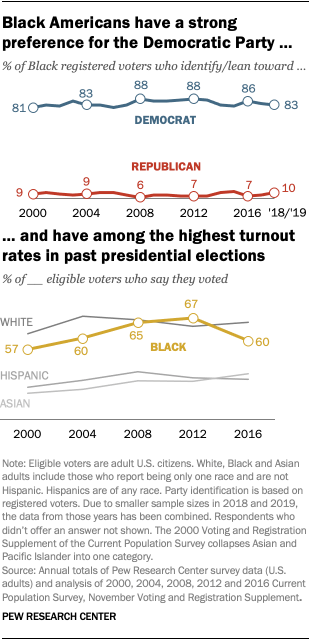
For many years, Black voters were the largest non-White racial or ethnic segment of the country's electorate, but for the first fourth dimension in a presidential election they volition exist outnumbered by Hispanic eligible voters, at 32 million.
For this twelvemonth's upcoming presidential election, a recent Pew Research Heart survey found that 63% of Black registered voters are extremely motivated to vote. Furthermore, among those who support Joe Biden, over a third (35%) said that they plan on casting or have already cast their vote past absentee or post-in ballot.
The Democratic Party has maintained a strong advantage amid Black voters, according to over two decades of Center polling. Black voters have as well recorded comparatively high turnout rates relative to other major racial and ethnic groups in recent elections – their levels closely matching White voter turnout rates in 2008 and 2012.
All the same Blackness eligible voters are by no ways monolithic in their views or demographics. In the half-dozen states with competitive races for president, Black eligible voters have varied levels of educational attainment, income and immigrant populations. Here are central facts about Black eligible voters living in this year's battleground states.
For this study, we analyzed the detailed demographics of Blackness Americans who are eligible to vote in the 2020 presidential election. The term "eligible voters" refer to persons ages xviii and older who are U.S. citizens. The assay is primarily based on information from the U.Due south. Census Agency's 2018 American Community Survey (the most recent year available) provided through Integrated Public Utilise Microdata Series (IPUMS) from the University of Minnesota.
Visit this page to read about how Pew Inquiry Center determined its categorization of battlefield states for the 2020 presidential elections.

Black eligible voters make up varying shares of the electorate in the battleground states. In Georgia, the state's 2.iv million Black eligible voters make up 32% of the electorate, the highest share amid these nine states. Meanwhile, in Arizona – a new battleground state that every Republican presidential candidate has won since 1952 (except in 1996) – Blackness Americans account for less than five% of the electorate. The share is fifty-fifty lower in Iowa, where Black eligible voters account for just three% of the country's overall electorate.
From 2000 to 2018, the share of Black eligible voters increased past five percent points in Georgia, the largest percentage point increase out of any battleground state. In Arizona, Florida, Due north Carolina, Iowa, Ohio, Pennsylvania and Wisconsin, the population's share rose by 1 to 2 points. And in Michigan, the population's share of the electorate was unchanged during this time. (2018 is the virtually recent year for which state level data is available.)
Trump won all nine states in 2016, though he did so by a razor-thin margin in 3 of them. He carried Michigan, Pennsylvania and Wisconsin – states where together about fourteen million people bandage a ballot – by less than 78,000 votes combined.
Across nearly battleground states, a majority of Black eligible voters live in the elevation three largest metropolitan areas in the country. In Georgia, Arizona, Pennsylvania, Michigan and Wisconsin, a large majority of Black eligible voters alive in each country'southward largest metro expanse. In Ohio, Florida, N Carolina and Iowa, Blackness eligible voters are more than evenly distributed across several metro areas.
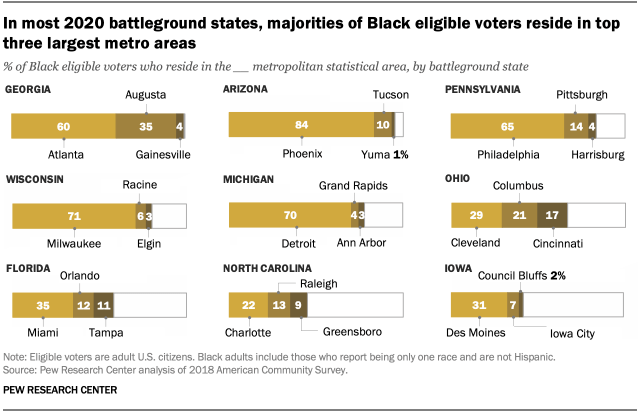
Four-in-10 Blackness eligible voters are Millennials or GenZers. In all nine battlefield states, Millennials (those ages 24 to 39 in 2020) make up a slight plurality – 29% to forty% – of all Black eligible voters. Gen Z eligible voters, the oldest of whom turn 23 this year, make upwards 15% or less of each land'due south Blackness electorate. Gen Xers and Infant Boomers each make upward around ane-fifth to one-quarter of the states' Black voting public, and those who are members of the Silent and Greatest generations comprise less than a tenth of Blackness eligible voters.
Compared with Blackness eligible voters, the nation'south overall electorate is comprised of slightly higher shares of those who belong to the Baby Boomer, Silent and Greatest generations and marginally lower shares of Gen Xers, Millennials and GenZers.
This slight generational departure is reflected in the median age of each corresponding group. The median age of the Black electorate is 44 in 2018, while the nation's overall is 48.

Nearly half of Black eligible voters in the nine battleground states attended at least some college, with Arizona (63%) having the highest share. But over half of Black eligible voters in the battleground states of Georgia (55%), Due north Carolina (55%), Michigan (53%), Ohio (52%) and Florida (52%) attended higher, while the shares are slightly lower among those in Pennsylvania (50%), Wisconsin (50%) and Iowa (47%).
Nationwide, more than one-half of Black Americans (54%) who are eligible to vote have at least some college education (this includes those with acquaintance degrees), compared with 62% of U.S. eligible voters overall.
The median incomes of Blackness households differ significantly amongst battleground states. Those residing in Arizona have the highest income levels within the six battleground states, at $50,000, followed past those in Georgia at $45,000 and Florida at $41,000. In North Carolina and Pennsylvania, Black eligible voters had median household incomes of $37,700 and $37,000, respectively. Those in Iowa ($28,800) and Wisconsin ($thirty,000) recorded the lowest household income levels among the nine states.
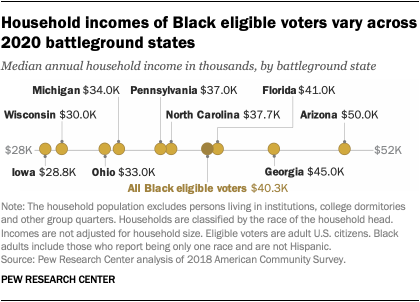
Overall, the median household income of the nation's Black electorate is about ii-thirds that of that country's entire eligible voter population – $twoscore,300 compared with $62,000.
While median incomes tin can vary widely among states, income inequality also exists among Black Americans overall. Black Americans almost the top of their income distribution (the 90th percentile) had incomes 9.8 times greater than the incomes of Black Americans almost the bottom of their income distribution (the 10th percentile), a gap that is exceeded merely past Asian Americans.
Poverty and health insurance coverage among Blackness eligible voters vary in swing states. Florida, Georgia and Iowa had the highest share of Blackness eligible voters without health insurance (xviii%), while Michigan had the lowest share (8%). In six battleground states, the uninsured charge per unit exceeded the national Black eligible voter average (xiii%). Meanwhile, the Black electorate in all 9 states had uninsured rates that equaled or exceeded that of the U.Due south. electorate overall (8%).
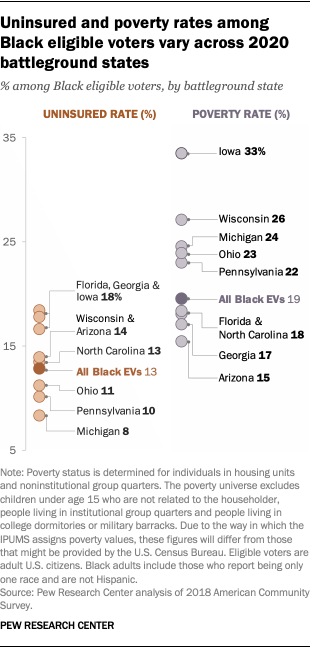
In terms of poverty rates, Black eligible voters in Iowa reported the highest shares of those living in poverty amidst battleground states at 33%. This is followed past Wisconsin (26%), Michigan (24%), Ohio (23%) and Pennsylvania (22%). All of these exceed the shares of those living in poverty among all Black eligible voters (19%) and U.Due south. eligible voters overall (xi%).
The uninsured and poverty rates of Black eligible voters reverberate national racial and indigenous disparities that accept been exacerbated by the coronavirus outbreak. In nearly every land, Blackness Americans accept accounted for a disproportionately higher share of COVID-19 deaths, and also have experienced widespread economic hardships.
A Pew Research Center survey in September found that since the U.S. coronavirus outbreak started in February, 43% of Black Americans said they had problem paying their bills, while 33% said they take gotten food from a food depository financial institution – higher shares than the 25% and xvi% of the full general public who said the aforementioned, respectively. Another survey conducted in the aforementioned calendar month institute that Black adults are more hesitant to trust medical scientists and to get vaccinated for COVID-19 if a vaccine was available.
Naturalized immigrants account for nigh i-in-v Blackness eligible voters in Florida, by far the highest share among battlefield states. By contrast, immigrants make upward less than 5% of the Blackness electorate in Ohio, Wisconsin, North Carolina and Michigan.
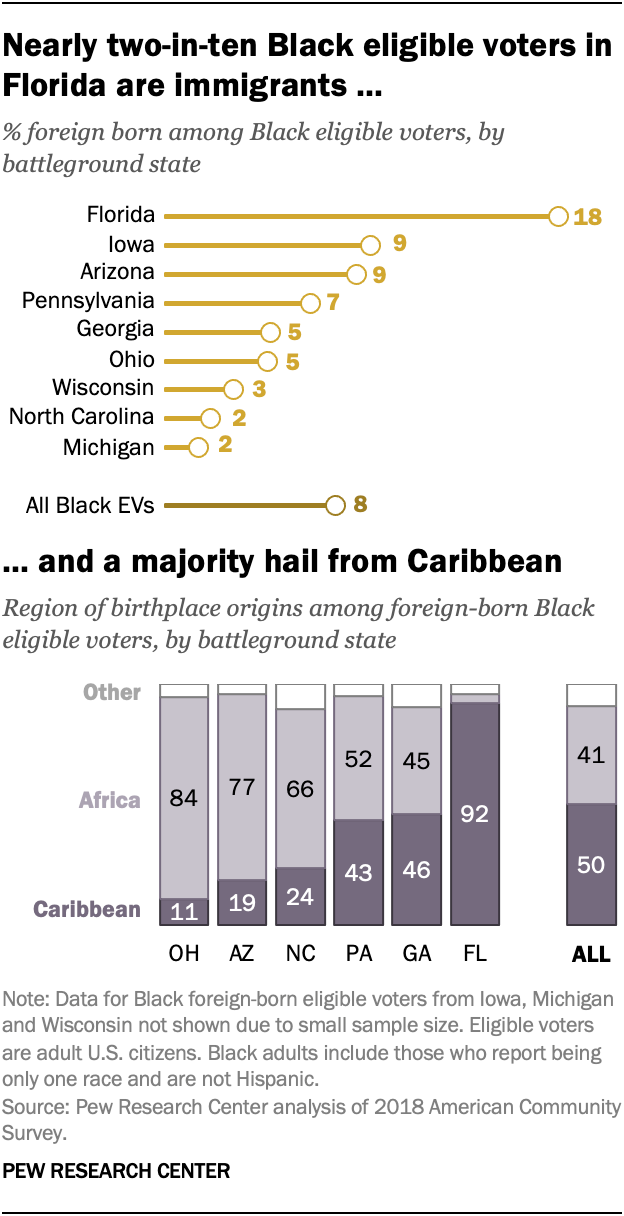
Immigrants have been an important driver in the growth of the state'due south Black eligible voter population. Between 2000 and 2018, the number of immigrants in the Black electorate nearly tripled from 800,000 to ii.3 million, and their shares doubled from four% in 2000 to 8% in 2018, according to Pew Inquiry Center assay of U.Southward. Census Agency data.
The top two regions of origin for this electorate are the Caribbean and Africa, with these regions accounting for l% and 41% of Black immigrant eligible voters, respectively. This reflects trends among the overall Black American strange-born population.
The top regions of origin tin differ greatly between battleground states. In Florida, the vast majority (92%) of its Blackness immigrant voting public hails from Caribbean nations such as Haiti and Jamaica. In Ohio, by dissimilarity, 84% of its immigrant Black electorate was built-in in African countries such as Ethiopia and Somalia.
Abby Budiman is a former research annotator focusing on race and ethnicity research at Pew Research Center.
Source: https://www.pewresearch.org/fact-tank/2020/10/21/key-facts-about-black-eligible-voters-in-2020-battleground-states/
Posted by: stewartartudistrums.blogspot.com


0 Response to "How Many Black Voters Are Registered To Vote"
Post a Comment